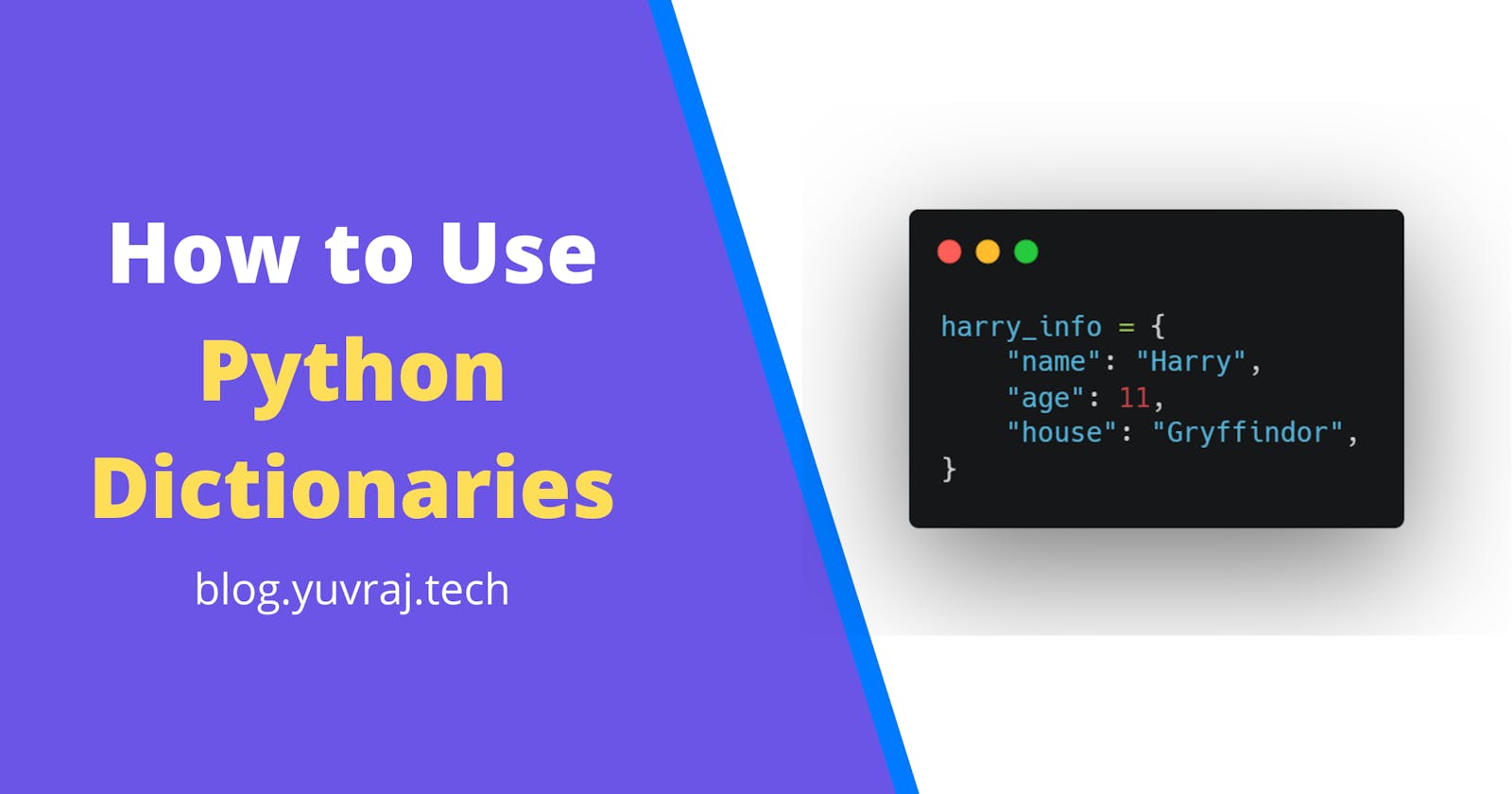How to Use Python Dictionaries
A Comprehensive Guide on Python Dictionary
Introduction
In this article, we will cover different ways of defining a dictionary, how to access and update values of a dictionary, the dictionary’s built-in methods, and how to use dict comprehension.
We will also learn about restrictions on keys of a dictionary, membership operators, pretty-printing a dictionary, and making a shallow copy vs deep copy of a dictionary.
What is a dictionary in Python?
Python provides several useful data types built-in, Dictionary is one such data structure.
A dictionary is a collection of key: value pairs where each value is accessed using a unique key.
This is in contrast to the list where elements are accessed using their indexes.
We can think of a dictionary as a table with two columns:

Highlights:
- A dictionary is a collection of key: value pairs where each value is accessed using a unique key.
How to define a dictionary?
We can define a dictionary in three different ways. Let's see each one of them by converting the above pictorial representation of the dictionary into a real python one.
Using curly braces {}
We can use the curly braces to define a dictionary by providing key-value pairs separated by a ':' as key: value:
harry_info = {
"name": "Harry",
"age": 11,
"house": "Gryffindor",
}
print(harry_info)
print(type(harry_info)) # <class 'dict'>
Notice that a dictionary can have values of different types.
We can also create an empty dictionary using {} as: empty_dict = {}.
Using dict() function
We can create a dictionary by passing a list of tuples to the dict function:
harry_info = dict([
("name", "Harry"),
("age", 11),
("house", "Gryffindor")
])
print(harry_info)
Using keyword arguments in dict()
We can provide keyword arguments to the dict function when all keys are string:
harry_info = dict(
name = "Harry",
age = 11,
house = "Gryffindor"
)
print(harry_info)
Values in a dictionary
A dictionary can store any type of value including another dictionary. Let's change the harry_info dictionary to contain a nested dictionary house and a list of friends:
harry_info = {
"name": "Harry",
"age": 11,
"house": {
"name": "Gryffindor",
"Animal": "Lion",
"Element": "Fire"
},
"friends": ["Ron", "Hermione"]
}
print(harry_info)
Tip 💡
When we print the above dictionary the output would not be very readable, we can use the pprint function to pretty print a dictionary:
from pprint import pprint
pprint(harry_info)
Output:
{'age': 11,
'friends': ['Ron', 'Hermione'],
'house': {'Animal': 'Lion', 'Element': 'Fire', 'name': 'Gryffindor'},
'name': 'Harry'}
Restrictions on keys
There are two restrictions we need to know when defining keys:
Duplicate keys are not allowed
If we define the same key twice, the second occurrence will override the first one:
duplicate_dict = { "first": 0, "second": 2, "first":1 } print(duplicate_dict)This will print:
{'first': 1, 'second': 2}✅and not
{'first': 0, 'second': 2}❌{'first': 0, 'second': 2, 'first': 1}❌Keys must be immutable
Keys must have a type that is immutable, which means any type whose value doesn't change once created like int, bool, str, float, etc.
That's why we can have a tuple as a key but not a list:
example_dict = { (1, 2): "Tuple", # Okay to use False: "Bool", # Okay to use 1: "int", # Okay to use [1, 2]: "list", # raises TypeError }Using a list as a key raises TypeError: unhashable type: 'list' because it is a mutable object.
Technically, a key requires a hashable value which means that Python's built-in hash() function should return a unique hash value for that object and all immutable types satisfy this condition.
Highlights:
- We can define a dictionary using:
- Key-value pairs in curly braces.
- Using dict function
- A dictionary can have any type of value.
- Key cannot be:
- Duplicated
- Mutable (more precisely unhashable)
How to access values in a dictionary?
We can access a value from a dictionary by using the square brackets [].
So dict_name[key] will return the corresponding value.
Let's try to retrieve some values from the harry_info dictionary:
print(harry_info["name"])
Output: "Harry"
print(harry_info["friends"])
Output: ['Ron', 'Hermione']
What if we try to retrieve a value using a key that doesn't exist?
Let's try that too:
print(harry_info["enemies"])
Output: KeyError: 'enemies'
We got a key error which means that we can not retrieve keys that don't exist using the square bracket syntax.
Adding a new key-value pair to the dictionary
As dictionaries are mutable structures, we can add new members by assigning values to new keys using the same square bracket operator:
Syntax: dict_name[new_key] = value
harry_info["enemies"] = ["Voldemort", "Death Eaters"]
Updating existing key-value pair of a dictionary
We can also update the key's values similarly using the square brackets:
Syntax: dict_name[key] = new_value
harry_info["age"] = 17
This will update the age key from 11 to 17.
Using Membership operator with dictionaries
We can use the in and not in operators to check whether a key exists in the dictionary or not:
print('name' in harry_info) # Output: True
print('name' not in harry_info) # Output: False
print('year' in harry_info) # Output: False
print('year' not in harry_info) # Output: True
Get the number of key-value pairs
Use the built-in len function to get the number of key-value pairs in a dictionary:
print(len(harry_info)) # Output: 5
Highlights:
- Access values using dict_name[key] syntax.
- Add a new value using dict_name[new_key] = value.
- Update a value using the same syntax as (2).
- Use in and not in operator to check for key existence in a dictionary.
- Use the len function to get the number of key-value pairs.
Built-in Dictionary Methods
get(key, default=None)
This is an alternative to the [] for accessing the values using a key from a dictionary. The difference is that we can provide a default value to return when a key doesn't exist instead of raising a key error.
print(harry_info.get("name")) # Output: Harry
print(harry_info.get("year")) # Output: None
print(harry_info.get("year", 7)) # Output: 7
items()
Returns a list of tuples containing the key-value pairs of a dictionary.
print(list(harry_info.items()))
Output:
[('name', 'Harry'), ('age', 17), ('house', {'name': 'Gryffindor', 'Animal': 'Lion', 'Element': 'Fire'}), ('friends', ['Ron', 'Hermione']), ('enemies', ['Voldemort', 'Death Eaters'])]
We can use the items method to loop through a dictionary:
for key, value in harry_info.items():
print(key, 'is', value)
Output:
name is Harry
age is 17
house is {'name': 'Gryffindor', 'Animal': 'Lion', 'Element': 'Fire'}
friends is ['Ron', 'Hermione']
enemies is ['Voldemort', 'Death Eaters']
keys()
Returns the list of all keys of a dictionary.
print(list(harry_info.keys()))
Output: ['name', 'age', 'house', 'friends', 'enemies']
values()
Returns the list of all values of a dictionary.
print(list(harry_info.values()))
Output: ['Harry', 17, {'name': 'Gryffindor', 'Animal': 'Lion', 'Element': 'Fire'}, ['Ron', 'Hermione'], ['Voldemort', 'Death Eaters']]
pop(key[, default])
Remove the specified key and return the corresponding value.
If the key is not found, d is returned if given, otherwise KeyError is raised.
print(harry_info.pop('enemies')) # enemies will be removed
print(harry_info.pop('invalid_key', "Invalid Key"))
print(harry_info.pop('invalid_key'))
Output:
['Voldemort', 'Death Eaters']
Invalid Key
KeyError: 'invalid_key'
popitem()
Remove and return the last (key, value) pair as a tuple, but raise KeyError if dictionary is empty.
print(harry_info.popitem())
Output: ('friends', ['Ron', 'Hermione'])
update(iterable)
Merges a dictionary with another dictionary or with an iterable of key-value pairs.
If the dictionary or iterable passed has the same key as the original dictionary then the value of that key is overridden.
When iterable is a dictionary
d1 = {'a': 1, 'b': 2, 'c': 3}
d2 = {'b': 200, 'd': 4}
d1.update(d2)
print(d1)
Output: {'a': 1, 'b': 200, 'c': 3, 'd': 4}
Notice how 'b' is updated and 'd' is added.
When iterable is a list of tuples
d1 = {'a': 1, 'b': 2, 'c': 3}
d1.update([('b', 200), ('d', 4)])
print(d1)
Output: {'a': 1, 'b': 200, 'c': 3, 'd': 4}
We can also provide a keyword arguments to update and the result will be the same:
d1 = {'a': 1, 'b': 2, 'c': 3}
d1.update(b=200, d=4)
print(d1)
Output: {'a': 1, 'b': 200, 'c': 3, 'd': 4}
fromkeys(iterable, value=None)
Create a new dictionary with keys from iterable and all values set to value.
keys = ("key1", "key2", "key3")
example_dict = dict.fromkeys(keys, "default value")
print(example_dict)
Output: {'key1': 'default value', 'key2': 'default value', 'key3': 'default value'}
setdefault(key, default=None)
Return the value for key if key is in the dictionary, otherwise insert that key with a value of default and return default.
# Returns value for 'name'
print(harry_info.setdefault("name"))
# Returns value for 'name', default is ignored
print(harry_info.setdefault("name", "Harry Potter"))
# Adds key 'last_name' and return its value 'Potter'
print(harry_info.setdefault("last_name", "Potter"))
Output:
Harry
Harry
Potter
copy()
Performs a shallow copy of the dictionary.
harry_copy = harry_info.copy()
print(harry_copy)
Shallow copy vs deep copy
With a shallow copy if the original dictionary contains mutable values they won't be copied, therefore changing the copied dictionary will change the original one.
We can use copy.deepcopy method to perform a deepcopy as shown below:
from copy import deepcopy
d = {
'number': 1,
'list': [1, 2]
}
d_shallow = d.copy()
d_shallow['list'].append(3)
print("shallow copy", d_shallow)
print("original dict", d) # d is also changed
d_deep = deepcopy(d)
d_deep['list'].append(4)
print("deep copy", d_deep)
print("original dict", d) # d is unchanged
Output:
shallow copy {'number': 1, 'list': [1, 2, 3]}
original dict {'number': 1, 'list': [1, 2, 3]}
deep copy {'number': 1, 'list': [1, 2, 3, 4]}
original dict {'number': 1, 'list': [1, 2, 3]}
clear()
Remove all items from a dictionary
harry_info.clear()
print(harry_info)
Output: {}
Highlights:
- Dictionary provides several methods to access, update, remove, and copy key-value pairs.
Dict Comprehension
You may be familiar with list comprehensions, it is an alternative to for loop and a concise notation to perform some operations for a collection of elements.
You can also write comprehension for a dictionary using the following syntax:
example_dict = {key:value for key, value in iterable}
where the iterable is a list of key-value tuples.
d1 = dict((k, v) for k, v in enumerate("Hello", 1))
print(d1) # {1: 'H', 2: 'e', 3: 'l', 4: 'l', 5: 'o'}
d2 = {k: v for k, v in enumerate("Bye", 1)}
print(d2) # {1: 'B', 2: 'y', 3: 'e'}
Enumerate function returns a key: value pair using the iterable passed to it and the start value.
You can learn more about comprehensions in Python in this article: Comprehension in Python: Explained.
Highlights:
- Use dict comprehension to perform operations on key-value pairs of a dictionary in a concise way.
Summary
- Dictionary is a mutable data structure to store key: value pairs.
- Define a dictionary using curly braces or dict function.
- Access or update values of a dictionary using square brackets.
- Dictionary provides built-in methods to add, update, remove, and copy key-value pairs.
- Use dict comprehensions to perform operations on dict in a concise way.
Thanks for reading.
If you found this article helpful, please like and share! Feedbacks are welcome in the comments.
You may also like:

